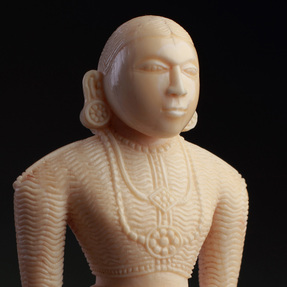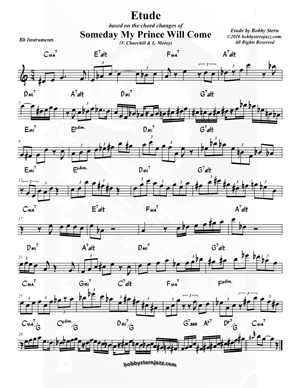For Your High-Ness:
An Etude on "Someday My Prince Will Come"
 "Heah come da Prince!"
"Heah come da Prince!" This tune has been in my repertoire for a while, but I started to take a closer look at it recently, for reasons I'll get into.
The music for "Someday My Prince Will Come" was composed and scored by Frank Churchill back in 1937 for the first ever full length animated Disney movie, "Snow White and the Seven Dwarfs".
I don't think I've ever actually seen the whole movie myself, but I think we all grew up knowing about little Ms. White and her seven vertically challenged buddies (Sleepy, Creepy, Peepee, Goofy, Doofy, Humpty & Dumpty....I think - off the top of my head; no?!?!?).
In any case, Someday My Prince has been a staple for improvising musicians and singers and has been recorded often - the definitive version possibly being Miles Davis' 1961 recording on Columbia (featuring tenor solos by both Hank Mobley and John Coltrane) from the album of the same name.

it's 32 bar ABAC song form,
3/4 waltz time and
simple but deceptive chord changes.
One of the first things I had to clear up for myself was how to understand and negotiate the D7 (concert) something in the second bar of of each A section (bars #2 & #17). As it relates to the melody notes - Bb & F# (concert), or b13 & 3 - I suspected some type of altered dominant scale possibility, so I went with D7altered scale material (Eb Melodic Minor) here..
One might first think of a D7 resolving to some kind of G (V7-I), but wait......it deceptively resolves to Eb Maj, which is a Maj 3rd down from G. The A in the melody would suggest an Eb lydian type of scalar approach. Actually, one might still think of it as G natural minor (aeolian) with an Eb in the bass.
The other interesting point - for me, probably the most interesting - is the descending Db dim.7 passing chord which takes place in bars #10 & #14, in the B, or second 8 bar section of the tune. What threw me a bit in the beginning was choosing which diminished scale sounds best here, half tone/ whole tone (Db-D-E-F-G-Ab-Bb-B) or whole/ half tone (Db-Eb-E-F#-G-A-Bb-C).
At first, the former choice of the half/ whole diminished scale seemed to make the most sense, since it contains all the notes of a G7b9#9#11 13 chord which is the V7 of the next chord - Cmin7, but it just didn't sound or feel right against the recordings, including the Aebersold track used in the audio example (link below) of this etude.
Why?
Because, I finally realized that the whole tone/ half tone diminished scale contains the notes of a C7 with a b9, #9, #11 & 13, the dominant of the root of the next chord after Cmin7; which is F7.
In fact, the A in the melody (13th of C7) in that measure is the giveaway, since it is present only in the whole/ half.
In other words, the Db dim7 in bars #10 & #14 basically functions as a C7b9 13 with the b9 in the bass (C13/ Db), or the II7 (V7 of V7) in the key of Bb. The whole purpose of most dim.7 passing chords, ascending or descending, is to facilitate the creation of a chromatic bass line; in this case D - Db - C and possibly F7/ B as a tritone sub in bars #9-12 and #13-17.
Uhh....I think I've got it now.
Getting to the etude specifically, I wrote it from my horn, phrase by phrase as I might play it and then tweaked it, where needed.
Some of my scale choices throughout are:
Melodic Minor over dominant 7th chords (measures #2, 4, 6-8, 12, 16, 18, 20, 24, 26 & 30)
Whole Tone/ Half Tone Diminished over dim. 7th chords in bars #10, 14 & 28.
I managed to sneak in an Augmented scale over the Eb Maj7 in bar #19, and a piece of the same scale again in bar #22.
Bars #11-12 and #15-16 are examples where I express the ii-V7 (C-7 / F7alt, in each case) intervallically - the Dorian mode for the ii and Melodic Minor for the V7alt; using intervals, for the most part, other than that of a second, although there are a few in there.
In bars #29-32, the focus is on the use of "digital type" patterns (i.e. 1235, (b)7123, etc.), a technique frequently employed by John Coltrane from ca. 1957 - 1961, give or take.
Bar #29 (Bb Maj7/ F) starts with a 3 4 5 6 (Bb Maj. scale) sixteenth note pattern the 2nd beat, moves down to a b3 4 5 6 (Ab Melodic Minor) sixteenth note group on the first beat of bar #30 (B dim7/ F, which is the same as G7b9), moving down to the G on the first 16th note of bar #31. This is where it gets kind of interesting. Originally I had the first group of 4 sixteenth notes as G-A-B-D, but removed the A to break up the stream a little bit. With the A still in there, the whole measure would read: 1235 in G;; 8 7 b7 8 over Bb7 (Mixolydian); 3 b3 2 b2 in Eb Maj.
If you didn't catch it already, the superimposed harmony in bar #31 that the line suggests (G - Bb7 - Eb) represents exactly one half of a complete Cycle of Descending Major thirds, or "Coltrane Change cycle, which would continue as (-Gb7 - B - D7) to complete the cycle.
As it is, the cycle continues in bar #32. The original lead sheet might say F7, the line says superimpose 1 2 3 5 in Eb; b7 1 2 3 of F#7; and 1 2 3 5 of B; which is the tritone sub of F7, (the V7 of Bb, the home key) and which resolves perfectly.
All this sounds especially good over these last four bars, since it is over an F pedal, which heightens the tension before going back Bb at the top.
Rhythmically, I felt a lot of triplets, which is something I'm still trying to smooth out the rough edges with.
A triplet feel undercurrent is going on all the time in this music, (listen to Elvin Jones) and there are ways to express it and break it up. I guess I also wanted to avoid steady streams of straight eighth notes and/ or constant 16th note feel. To to achieve a rhythmic balance within the phrases themselves, I've tried to mix it up.
I think there's a lot of practice material here. Maybe take it a line at a time. Isolate some of the ii-V7s and play them through the keys. Use your imagination and have as much fun with it as I did.
For the recorded example, I used a short piece at the beginning of the track from Aebersold Play-a-Long #58 "Unforgettable Standards".

 RSS Feed
RSS Feed









